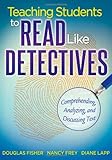Teaching students to read like detectives : comprehending, analyzing, and discussing text / Douglas Fisher, Nancy Frey, Diane Lapp.
Material type: TextLanguage: English Publication details: Bloomington, IN : Solution Tree Press, c2012.Description: xi, 156 pages : illustrations ; 26 cmISBN:
TextLanguage: English Publication details: Bloomington, IN : Solution Tree Press, c2012.Description: xi, 156 pages : illustrations ; 26 cmISBN: - 9781935543527 (perfect bound)
- 9781935543534 (library edition)
- 372.47
- LB 1573.7 F533t 2012
| Item type | Current library | Home library | Collection | Shelving location | Call number | Copy number | Status | Date due | Barcode |
|---|---|---|---|---|---|---|---|---|---|
 Libro
Libro
|
Biblioteca Juan Bosch | Biblioteca Juan Bosch | Humanidades | Humanidades (4to. Piso) | LB 1573.7 F533t 2012 (Browse shelf(Opens below)) | 1 | Available | 00000120116 |
Includes bibliographical references (p. 139-152) and index.
Introduction: comprehension occurs through text-based analysis and discussion -- Readers and texts: why both are necessary for understanding -- Argumentation: gateway to text-based analysis and discussion -- Analyzing and discussing narrative texts -- Analyzing and discussing expository text -- Analyzing and discussing new-media texts.
Empower students to take ownership of their reading and learning with Teaching Students to Read Like Detectives. In this comprehensive guide, the authors explore the relationship between text, learner, and learning through discussion and rhetorical writing at the elementary, middle, and high school levels. Prompt students to become the sophisticated readers, writers, and thinkers they need to be to achieve higher learning. Clearly defined strategies will drive discussion-based learning. Examine the hidden dangers of controlling classroom discourse, foster critical literacy through questioning and instructional routines, and encourage students to find meaning and cultivate thinking from expository texts--even the most challenging ones. Finally, because all students learn differently, you'll explore new-media texts and web 2.0 to accommodate learning differences among your students. Benefits: Investigates how educators can establish an inquiry-based and reflective classroom; Presents methods to help students engage deeply with their own ideas; Provides student and teacher dialogues, teacher modeling, and graphic organizers; Includes sample assignments, organizational routines, and instructional strategies; Illustrates how readers can build understanding of literary and expository texts; Contains techniques to make classroom discussions productive and safe.


There are no comments on this title.